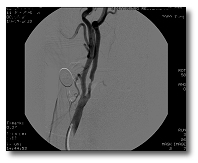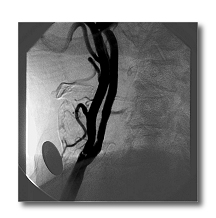
|
|
INTERVENTIONAL RADIOLOGY
MEDICINE OF THE 21st CENTURY
What is Interventional Radiology?
Interventional Radiology is an exciting new medical specialty that utilizes
various imaging modalities such as CT scans, angiography, MRI, and
ultrasound to diagnose and treat many disease processes without surgery.
Specially trained
physicians called Interventional Radiologists are able to perform most of
these procedures as an outpatient with less discomfort, risks, complications
and cost, but with much greater patient satisfaction.
What are the benefits of Interventional Radiology?
• Patients may avoid surgery altogether
• Local anesthesia with intravenous sedation is used Instead of general
anesthesia
• Cardiac, respiratory and other complications are less
likely
• Less blood is lost
• Recovery times are reduced when major surgery is
avoided. Most patients are able to resume their normal activities within a
few days
• Quality of life is improved by rapid diagnosis and treatment
• Allows patients who are otherwise unfit for surgery, to still receive
treatment
• For some patients, this is the only safe treatment available
Interventional Radiologists specialize in diagnosing and treating diseases
involving the blood vessels (arteries and veins) and in virtually every
organ. This includes minimally invasive treatments and pain management
procedures.
Pain Management Services
Vascular Services
-
Arteriography & Venography: Iodinated contrast , Carbon Dioxide and alternative contrast agents
-
Balloon Angioplasty & Stent Placement: open up narrowed or blocked blood vessels
-
Arterial & Venous Thrombolysis & Thrombectomy: dissolve and/or remove blood clots in arteries and veins
-
IVC Filter Placement: prevent pulmonary embolism
-
Foreign Body Retrieval: remove foreign bodies such as catheter fragments without surgery
-
Embolization: treat internal bleeding, fibroids or tumors by blocking blood flow
-
Venous Access including Ports and Tunneled catheters: more accurate catheter placement using ultrasound guidance or fluoroscopy; even when veins are blocked
-
AV Graft Hemodialysis Thrombectomy/ Thrombolysis & Fistulograms
Additional Procedures
-
Uterine Fibroid Embolization for uterine fibroids: non- surgical treatment alternative
-
Chemoembolization for Hepatic Neoplastic Disease
-
Radiofrequency Ablation of liver, lung, kidney and bone tumors: adjunctive treatment of tumors
-
Carbon dioxide Percutaneous Gastrostomy or Gastrojejunostomy Placement: place tubes without requiring endoscopy, surgery or a nasogastric tube
-
Percutaneous Nephrostomy and ureteral stenting
-
Bilary Interventions: Percutaneous Cholangiogram, brush biopsy, stenting, gallstone retrieval: drain/treat biliary obstructions
-
Transjugular Intrahepatic Portosystemic Shunt (TIPS) and Transjugular Liver Biopsy: treat ascites and complications of portal hypertension
-
CT or Ultrasound Guided Needle Biopsies and Drainages: diagnose tumors/drain fluid without surgery